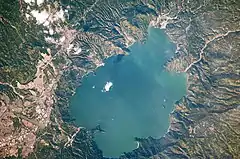Tierra Blanca Joven eruption
The Tierra Blanca Joven eruption of Lake Ilopango was the largest volcanic eruption in El Salvador during historic times with a Volcanic explosivity index of 6, dating back in the mid 5th century A.D. The eruption ejected about 44–95 km3 (11–23 cu mi) of dense rock equivalent.[1][2] The eruption was one of the largest volcanic events on Earth in recorded history, i.e. within the last 7,000 years. The date of the eruption is constrained to be within 429–433 CE by identifying volcanic ash in precisely dated Greenland ice core thus eliminating it as the cause of extreme weather events of 535–536.
| Tierra Blanca Joven eruption | |
|---|---|
 | |
| Volcano | Lake Ilopango |
| Date | 431 ± 2 CE |
| Type | Ultra-Plinian |
| Location | El Salvador, Central America 13.67°N 89.05°W |
| VEI | 6 |
 The estimated ashfall in the region during the Tierra Blanca Joven eruption. The ash covered at least 10,000 km2 (3,900 sq mi). The red spot is the ash at the bottom of the image. | |
Volcanic eruption
The Tierra Blanca Joven eruption is El Salvador's largest volcanic eruption in the last 10,000 years. This VEI-6 Plinian eruption occurred during the 5th century and was larger than the 1883 eruption of Krakatoa or the 1991 eruption of Mount Pinatubo, having probably been more comparable to the 1815 eruption of Mount Tambora.[3] It produced about 104–207 km3 (25–50 cu mi) of tephra (several times as much as the 1980 eruption of Mount St. Helens), produced major pyroclastic fall and large pyroclastic flows that covered 10,000 km2 (3,900 sq mi) under 50 cm (20 in) or more of pumice and ash. The eruption devastated an area of up to 100 km (62 mi) radius around the volcano. Having produced more than 44–95 km3 (11–23 cu mi) of dense rock, the Tierra Blanca Joven eruption is one of the largest volcanic events on Earth in recorded history.[4]
See also
References
- Dull, Robert A.; Southon, John R.; Kutterolf, Steffen; Anchukaitis, Kevin J.; Freundt, Armin; Wahl, David B.; Sheets, Payson; Amaroli, Paul; Hernandez, Walter; Wiemann, Michael C.; Oppenheimer, Clive (2019). "Radiocarbon and geologic evidence reveal Ilopango volcano as source of the colossal 'mystery' eruption of 539/40 CE". Quaternary Science Reviews. 222: 105855. Bibcode:2019QSRv..22205855D. doi:10.1016/j.quascirev.2019.07.037. ISSN 0277-3791. S2CID 202190161.
- Smith, Victoria C.; Costa, Antonio; Aguirre-Díaz, Gerardo; Pedrazzi, Dario; Scifo, Andrea; Plunkett, Gill; Poret, Mattieu; Tournigand, Pierre-Yves; Miles, Dan; Dee, Michael W.; McConnell, Joseph R.; Sunyé-Puchol, Ivan; Harris, Pablo Dávila; Sigl, Michael; Pilcher, Jonathan R. (2020-10-20). "The magnitude and impact of the 431 CE Tierra Blanca Joven eruption of Ilopango, El Salvador". Proceedings of the National Academy of Sciences. 117 (42): 26061–26068. Bibcode:2020PNAS..11726061S. doi:10.1073/pnas.2003008117. ISSN 0027-8424. PMC 7584997. PMID 32989145.
- "Ilopango". www.volcanodiscovery.com.
- Colossal volcano behind 'mystery' global cooling finally found. National Geographic. 23 August 2019.